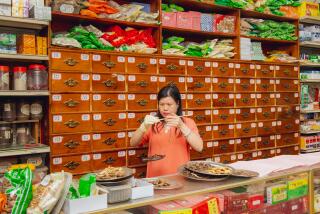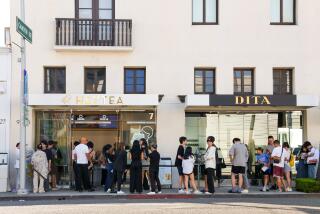Drinking in the culture of tea
- Share via
When my husband, Michael, and I arrived in this southern town in the dog days of last summer, we did what most people do here when the weather is humid and the temperature climbs to more than 100 degrees.
We bought peaches from the fruit vendor on the street below our apartment and let the warm juice run down our forearms and drip off our elbows. We walked, panting, over the delicate stone bridges at West Lake, through the gardens along its shore, past the forest of lotuses and the red carp in its fishponds, catching any breeze we could.
FOR THE RECORD
Hangzhou, China — An article in the Sunday Travel section incorrectly reported that China Eastern flies nonstop to Shanghai’s Hongqiao Airport. China Eastern flies nonstop from Los Angeles International Airport to Shanghai’s Pudong International Airport.
Despite the heat, we couldn’t find a cold drink. Instead, locals encouraged us to drink warm liquids to help our bodies adjust to the climate.
The beverage of choice?
At almost every restaurant or friend’s home — whether in a water glass, elegant china or a thin, disposable plastic cup — we were served a steaming cup of “Xi Hu Longjing Cha” — West Lake Dragon Well tea.
In Hangzhou, tea plays a far more prominent role than simply accompanying little cakes and sandwiches without crusts. West Lake Dragon Well tea, grown in the hills surrounding the town and consumed in almost every establishment within it, is the region’s specialty.
Hangzhou, tucked into a bay off the East China Sea about three hours southwest of Shanghai and at the southern end of the Grand Canal, is a popular tourist destination for the Chinese. Despite its popularity, it’s a relatively quiet place. We came here to teach English for a year, figuring that we too could experience some of China’s rich culture away from the largely Westernized metropolises, such as Shanghai.
As the capital of China during the Southern Sung Dynasty in the 12th and 13th centuries, Hangzhou hosted many international traders and artists and became the country’s principal economic and cultural city. Its central attraction, the mist-laden West Lake, enchanted Venetian explorer Marco Polo when he passed through in the 13th century. He called Hangzhou “a noble and magnificent city.”
Although the country’s political upheaval in the last century destroyed much of its historic architecture, the 2,200-year-old city has retained some of its most significant landmarks, such as Lingyin Temple, one of the largest Buddhist temples in China. During its golden age in the 10th century, the temple contained more than 1,300 rooms and was home to about 3,000 monks. Last year, as part of a massive 10-year-old restoration campaign, the city rebuilt the temple’s Leifeng Pagoda.
Today in Hangzhou, you can shop for silk in the extensive street markets, explore the gardens and pagodas surrounding the lake, sample the thriving nightlife in the brightly lighted clubs along Nanshan Road or lounge the day away in the teahouses, sipping steaming cups of Dragon Well and other teas.
Tea is, of course, popular everywhere in China, but few places enjoy Hangzhou’s reputation for tea culture — an undefined element that seems to encompass all things related to tea, including growing it, picking it, reading or writing poetry and songs about it and, of course, drinking it.
After winter began, I realized just how pervasive the tea culture in Hangzhou was. Dora Lei, a Chinese colleague from the boarding school where Michael and I are teaching, took us to Qing Teng Cha Jia, or Ivy Teahouse, to escape the chill in our apartments and relax. From the outside, the teahouse looked like any other beige concrete building common on most Chinese streets. But once I stepped through the doors, the atmosphere came alive.
Lilting traditional music crept around lacquered wood panels, and the sound of water drew my eyes down to the floor, where a stream carried red carp under a partly transparent bridge. Green plants hung everywhere. To my left, a group of children sat at a low square table, making figures in clay while a teacher-cum-baby-sitter oversaw their efforts. Through open doors of the private rooms, I spied families playing cards and couples laughing. One man lay across two chairs, snoozing.
As at many teahouses in Hangzhou, the price of a pot here buys hours of lazing around, snacking and drinking — a favorite activity for locals and visitors. I ordered a pot of oolong tea, served gongfu style, a method of presentation that goes back centuries. A slender young woman brought me a wooden box with slats, and on it sat a teapot made of purple sand clay — one of the most prized materials for Chinese teapots — a clay pitcher and two cups. The squat cup was about the size of half a tangerine; the taller, narrow one would have just fit over my index finger.
She poured piping water into the pot, already crammed with black leaves, and then emptied the liquid over the other vessels. “This is to wash the cups,” she said.
Then with quick, graceful movements, she refilled the pot and drained its contents into the pitcher, then poured that into the narrow cup, turned the squat cup upside down over its narrow cousin, flipped them over and removed the narrow cup. She rolled it between her hands and inhaled. “This is for the fragrance,” she said.
We passed it among us, and the smoky wooden scent emanating from the clay made my mouth water.
“This is to drink,” she said, handing me the tangerine-size vessel.
I raised it between thumb and forefinger and tossed back its contents in three gulps, as the server instructed. Our tea party had begun.
The Ivy Teahouse, one of Hangzhou’s newest establishments, carries on the city’s long reputation as a place to contemplate the finer things in life — nature, art and, of course, tea.
These days tea, especially fine-quality Dragon Well tea, is expensive — often displayed in luxury shops like jewelry. Yet many of the poorest locals consider it a necessity. The leaves of Dragon Well, brilliant emerald green spears about 3/4 inch long, are renowned throughout China for their beauty. Many a Chinese poet has waxed sentimental over their swirling dance in a cup. In ages past, emperors demanded Dragon Well tea as tribute, and it was offered as a gift to President Nixon when he came to China in 1972.
“Not all Chinese people like tea,” said our friend whose English name is George, over a dinner of Hangzhou specialties at another restaurant in town.
“When I was younger, I did not drink tea. It gave me a stomachache,” he said. Now we often see him with a cup of tea. “People say it is very healthy.”
Supposed cure-all
According to legend, 2,700 years ago, the mythical ruler Shen Nung, nicknamed “Holy Farmer,” was in the habit of tasting herbs to find those with medicinal value. Not surprisingly, he often poisoned himself, but he finally found a plant that could help drain the toxins from his body: tea.Today, Dragon Well tea is said to help everything from losing weight to improving eyesight to curing cancer. Through the centuries, tea has gained a niche in the lives of the Chinese, particularly the teahouses that line West Lake and huddle in the valleys of the surrounding hills.
“The whole of Hangzhou city is a large natural ‘teahouse,’ ” said tea expert Wang Ling in his book “Chinese Tea Culture.” I didn’t realize what he meant until one brisk autumn afternoon as I wandered the grounds of the National Chinese Tea Museum southeast of West Lake. I spotted some empty, wide stone steps leading into the hills. The steps rose into a shady forest of bamboo and other shrub-like trees. The minutes turned into an hour before I reached a peak. In the distant mist below me stretched West Lake’s Su Causeway. Behind me in a breathtaking scene, small tea villages nestled in valleys, with rows of tea bushes clothing the surrounding hills like green corduroy.
The paths, I discovered, stretch between many of Hangzhou’s landmarks in the hills: Tiger Spring, Meijiawu, the tea villages and Lingyin Temple in the northwest. After winter set in, my friend Chi Dan and I spent sunny weekend afternoons exploring them.
Colder, sunless days drove us indoors, sometimes to the Ivy Teahouse, where I drank gongfu tea as we nibbled on spring rolls, hazelnuts and quinces, and played cards. On one such occasion I wandered through hallways full of laughing families to fetch more fruits, nuts, dried meat and bamboo from the buffet. Suddenly, the lights went out, and I made my way back to our room.
“Bad luck,” I thought. “The power’s gone; the heat will go with it — we haven’t escaped the cold after all.”
I joined my glum companions in our room, where we sat until someone brought us a candle. Then I poked my head out the door — the place was ablaze with candles, their light bouncing off the water and the glossy lacquered surfaces of the wooden scrollwork framing the doors and windows. It was so lovely that I was almost disappointed when the power returned a few minutes later.
I ordered another glass of Dragon Well tea, spiked with little yellow osmanthus blossoms, and finished the evening on a warm note.
*
(BEGIN TEXT OF INFOBOX)
Going to a tea party
GETTING THERE:
From LAX, Air China International, China Southern, Asiana and China Eastern offer connecting flights (change of plane) to Hangzhou. Restricted round-trip fares begin at $1,853.
China Eastern has nonstop flights to Shanghai’s Hongqaio airport. Air China International offers connecting flights (change of plane). Restricted round-trip fares begin at $881.
JAL, All Nippon Airways, Northwest, United, Air Canada, Thai, China Southern, Philippine and Asiana offer connecting flights to Shanghai’s new Pudong airport. Restricted round-trip fares begin at $1,000.
From Shanghai, take the fast train to Hangzhou, which takes about two hours and costs $4-$5.
TELEPHONES:
To call the numbers below from the U.S., dial 011 (the international dialing code), 86 (the country code for China), 571 (the area code) and the local number.
WHERE TO STAY:
If you arrive by train, representatives from various hotels probably will meet you at the station and try to persuade you to stay with them. You might find a good deal — perhaps as low as $20 a night — but look at the room first. And remember, as with most purchases in China, you can often bargain.
Shangri-La Hotel, 78 Beishan Road; 8797-7951, https://www.shangri-la.com . A classy, peaceful establishment where many staffers speak English. Doubles $127, $187 for a room with a view of West Lake, including breakfast.
Merchant Marco Hotel, 38 Pinghai Road; 8701-8888, https://www.mcmchotel.com . In downtown with easy access to Hangzhou’s eclectic night market, just a block away. Doubles from $58.
Xizi Hotel, 37 Nanshan Road; 8702-1888, https://www.sinohotelguide.com/hangzhou/xizi . Doubles from $75. Online discounts available.
WHERE TO EAT:
You can find cheap lamb kebabs, noodle shops and other munchies at stalls on the street for as little as 25 cents.
Qing Teng Cha Jia (Ivy Teahouse), 278 Nanshan Road; 8702-2777. Has about 50 varieties of tea for $4.60-$12 for a pot or cup, including snacks, such as dumplings, fruit or soup.
Cha Tea, 105 Nanshan Road; 8791-6422. On the edge of West Lake. Brews $2.20-$30.50, snacks 70 cents-$2.20, main courses $2.40-$4.90. Try the excellent stewed beef in sha tea for $3.30.
TO LEARN MORE:
China National Tourist Office, (818) 545-7507, https://www.cnto.org .
— Bethany Beaupain
Bethany Beaupain is an English teacher living in Hangzhou.
More to Read
Sign up for The Wild
We’ll help you find the best places to hike, bike and run, as well as the perfect silent spots for meditation and yoga.
You may occasionally receive promotional content from the Los Angeles Times.






